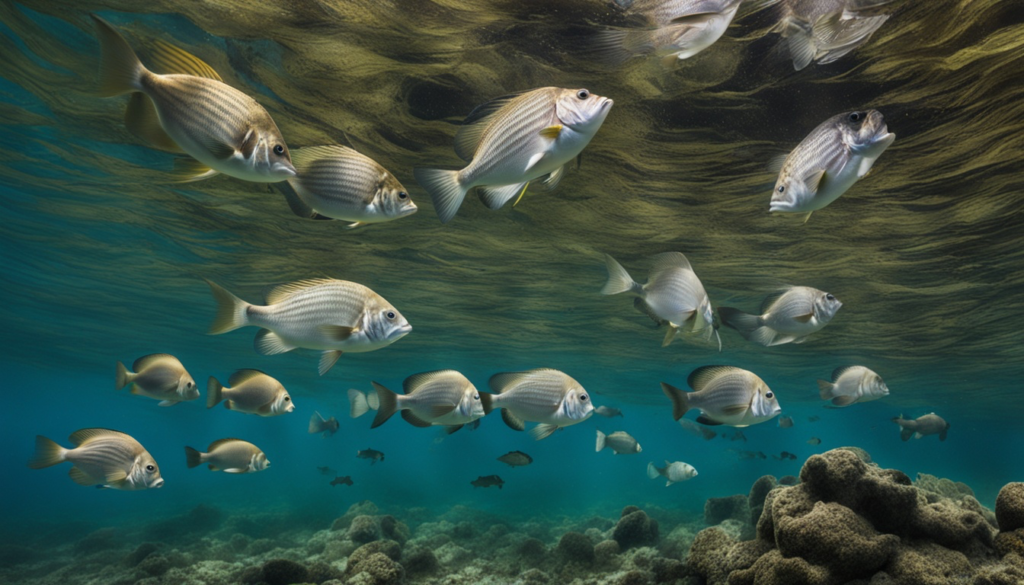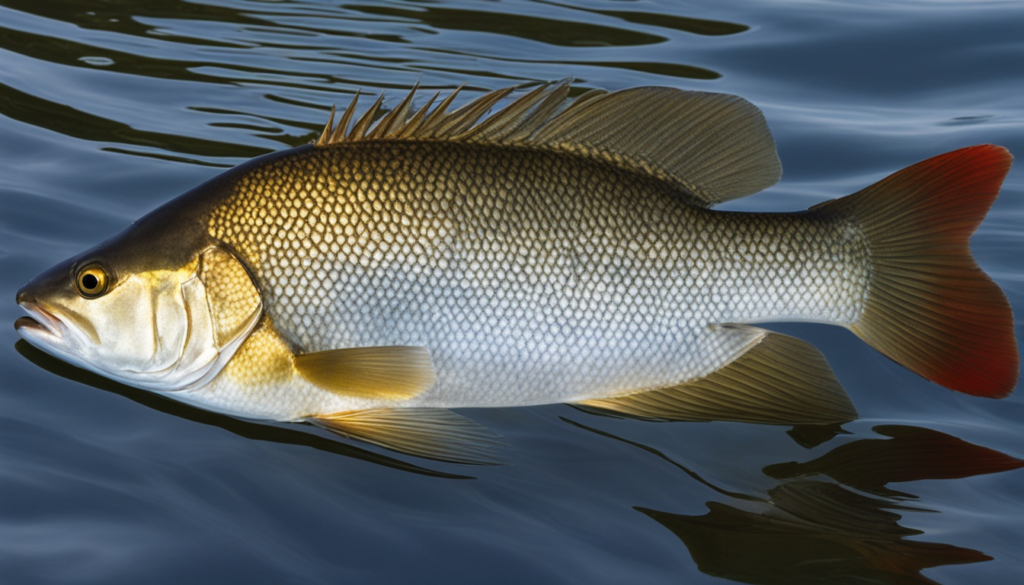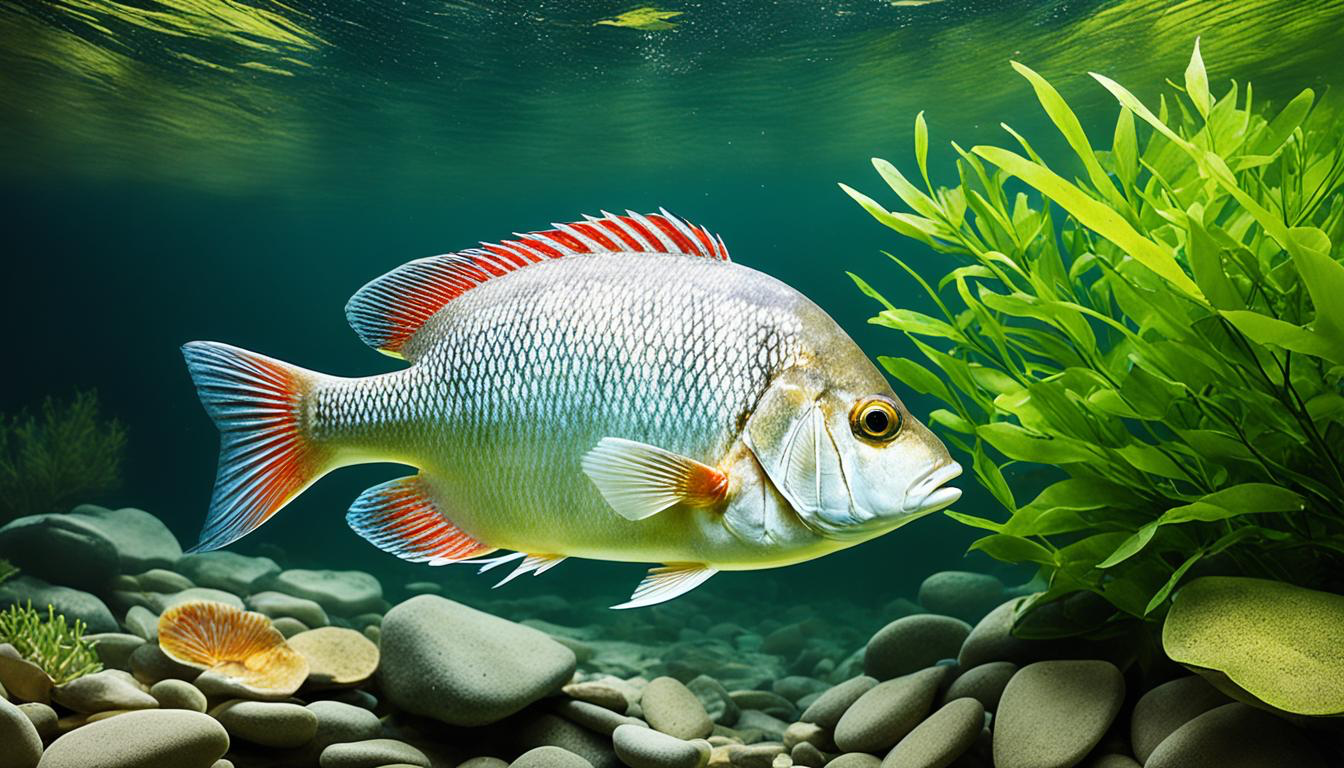The rhythmic beats of grunts in North America’s freshwater signal the Aplodinotus grunniens. This species, also called the freshwater drum or sheepshead fish, is special. It’s the only one of its family living only in fresh waters. From the big Mississippi River to quiet Hudson Bay, the drum adds its unique sound. It loves living along sandy and muddy bottoms that these waters offer.
Anglers admire the drum not just for its fight, but for its beauty too. Need proof? Native Americans made jewelry of its otoliths, a kind of ear bone. Its big appetite might even help control invasive zebra mussels. This fish spans from warm Guatemala to the cooler waters of Kansas and Oklahoma. It’s more than a catch; it’s a window into how species adapt and affect their homes.
The freshwater drum proudly shows off its size, with an average of 10-14 inches in length. They tip the scales at 5–15 lb. Yet some are giants like the 54 lb 8 oz world record fish.
But there’s more to them than just size. They have a history, living up to 72 years, like those in Minnesota’s Red Lakes. They’re a living part of North America’s water story.
The Unique Vibes of Freshwater Drum: Nature’s Own Grunters
The freshwater drum makes unique sounds in America’s rivers and lakes. Known as the thunder pumper or gaspergou, their noise stands out. They produce this grunt by vibrating muscles against their swim bladder. This not only makes them special but shows their complex behaviors during mating.
Understanding the Grunting Phenomenon
The grunting is loudest when it’s spawning season, especially from mature males. They make this sound by tightening and relaxing muscles around the swim bladder. This creates a growling sound. The purpose and benefits of this grunt are still being researched by scientists.
Significance of the Freshwater Drum’s Vocalizations
Their grunting is crucial for mating and claiming territory. It helps females find mates in dark waters. These sounds might also keep predators and rivals away from their spawning sites.
Colorful Folk Names
Their unique sound has led to different names in various places. They’re called ‘thunder pumper’ for their deep grunts or ‘gaspergou’ in French-influenced areas. These names reflect the culture and stories of the people who live there. They show how the freshwater drum sparks curiosity and imagination.
The freshwater drum surprises anglers and entices mates with its sounds. It remains a fascinating topic for research and fishing stories. It’s known as one of nature’s unique sound-makers.
Sheepshead Fish, Freshwater Drum, Aplodinotus Grunniens
The Aplodinotus grunniens is unique to the Sciaenidae family. It’s known as sheepshead or freshwater drum. It has many names like gray bass and Gasper goo, showing its popularity across North America.
Exploring the Taxonomy and Nomenclature
The freshwater drum, Aplodinotus grunniens, is special because it only lives in freshwater in North America. It adapts well and can live in different water conditions. This makes it stand out in the world of North American fish.
Physical Characteristics and Size Variations
Freshwater drums have a unique look. They have a big body, a high back, and a sloping forehead. In murky water, they appear gray or silver. But in clear waters, they turn brown or bronze.
These fish can weigh between 5-15 lb. The biggest one ever found was over 54 lb in Tennessee’s Nickajack Lake. They have a split dorsal fin, which helps identify them and is important for swimming.
Knowing about the freshwater drum helps us value its place in nature and why fishermen like it. Its ability to adapt and unique features interest scientists and fishers alike.
Key Habitat and Distribution: From the Great Lakes to Guatemala
The freshwater drum lives in many places, from the cold Hudson Bay to warm Guatemalan waters. They are tough and important in different water types. Yet, they prefer places with just the right conditions.
Adapting to Turbid Waters
Freshwater drum are often found in murky river and lake waters. They’ve adapted to survive in such unclear conditions. Their ability to live here makes them key players in food chains, especially in the Great Lakes. Here, they are both hunters and food.
Home is Where the Sand or Mud is
These fish like areas with sandy or muddy bottoms. This makes it easier for them to find food and reproduce. Because of this, they’re found all over North America, like in Lakes Michigan, Huron, Erie, and Ontario.
| Feature | Description |
|---|---|
| Habitat Preference | Rivers and lakes with sand or mud bottoms, typically in turbid waters. |
| Geographical Spread | Extends from Hudson Bay to Guatemala in North to South, and widespread in the Great Lakes. |
| Environmental Adaptability | Thrives in both clear and turbid water conditions, showing resilience across various environments. |
Ecosystem Impact: The Freshwater Drum’s Role

The Freshwater Drum plays a huge part in its ecosystem. It’s known for its ability to live in a range of North American waters. Its eating habits and how it competes are key. They shape the lives of other aquatic life and the ecosystem’s balance.
Dietary Preferences and Predation
The Freshwater Drum mainly eats benthic macroinvertebrates. This diet helps keep the bottom-dwelling community healthy. By eating things like bivalve mussels, they control these populations. They also help with nutrient cycling in the riverbeds.
As predators, they eat small fish, making them both competitors and predators underwater. This role is key at all their life stages. When young, they are preyed upon by fish like the smallmouth bass and walleye.
Competing for Resources with Other Species
Adult Freshwater Drums are strong when it comes to competing for food. They often go head-to-head with fish like the yellow perch and black bass. The battle for food increases where they share the same space, especially at feeding sites.
The drum adjusts its diet with the seasons. This change allows them to tap into different food sources. For instance, they eat dipterans in spring and fish like Gizzard shad from late summer to fall. This flexibility shows how they handle competition for resources.
| Season | Main Diet Components | Competitive Interaction |
|---|---|---|
| Spring | Macroinvertebrates, Dipterans | Low competition with fish species |
| Summer to Fall | Bivalve Mussels, Small Fish (e.g., Gizzard Shad) | High competition with predatory fish |
| Year-round | Macroinvertebrates, Small Benthic Fish | Medium competition with Yellow Perch, Black P |
By learning about the Freshwater Drum’s dietary habits and its rivalries, experts can better look after both the drum and other creatures in the same environments. This knowledge is crucial for managing their living spaces and keeping fish populations in check.
Lifecycles and Reproduction: The Spawning Saga
The spawning of the freshwater drum is a crucial event. It reveals how nature and biology work together to keep the species going. The eggs are laid in June and July when the water is around 65°F. This warm temperature starts a natural process that helps the species survive.
How soon freshwater drums mature is interesting. It varies due to genes and their environment. Males are ready to reproduce at about four years old. Females take a little longer, usually five to six years. This shows how they adapt to their surroundings.
Their breeding involves a method called broadcast spawning. During this, females release eggs into the water and males release sperm at the same time. This helps the eggs get fertilized outside the body. Most eggs are eaten soon after they’re laid. But some survive and grow into new freshwater drums.
Broadcast spawning is used by many water creatures. It shows how fragile yet tough the early life of a freshwater drum can be. Spreading eggs in large areas improves their chances of surviving despite predators. It also highlights the environmental challenges they face.
Learning about how freshwater drums spawn and grow teaches us about their role in nature. It also helps with efforts to keep them safe. Their life story is a fascinating tale of overcoming challenges to reproduce and evolve.
Sheepshead vs. Freshwater Drum: Identifying Characteristics

It’s important for fish lovers and scientists to tell Sheepshead and Freshwater Drum apart. They are often confused because they’re both called sheepshead in some places. However, they look different. The Freshwater Drum has a curved back, a sloping head, and a long dorsal fin. Its skin is gray but looks purple in some lights.
The Freshwater Drum’s lateral line is very sensitive and helps it feel water vibrations. This is a big clue for telling it apart from other fish. These fish vary in size, usually between 10-14 inches. They can grow bigger under the right conditions. They like big, murky rivers like the Mississippi and move fast thanks to their unique tail shape.
Looking at the dorsal fin is another way to tell them apart. Freshwater Drums have a two-part dorsal fin, with spines in the front and soft rays behind. This special fin helps them swim better.
Knowing their body shape, scale color, fin structure, and lateral line setup helps identify them correctly. Right identification is key for managing fish populations and studying the environment. This is especially true in places where different fish species live together.
Zebra Mussel Consumption: Is the Freshwater Drum an Eco-Warrior?
Studies on the freshwater drum’s diet have piqued interest for their part in aquatic ecosystems. Specifically, their battle against invasive species like zebra mussel. This bottom feeder prefers zebra mussels, which hurt native mussels and the ecosystem.
Sorting out Selectivity of Sizes in Drum Diet
The eating habits of the freshwater drum change with age and size. Younger drums go after smaller zebra mussels they can crush easily with their strong pharyngeal teeth. In contrast, adult drums are less choosy and eat more and bigger mussels, helping control these invasive species.
Assessing the Impact on Invasive Species Populations
While freshwater drums help control zebra mussel numbers, they don’t do enough to stop their spread. Studies show that, despite their efforts, tackling zebra mussel overpopulation demands a combined effort from many species and strategies in the ecosystem.
The freshwater drum’s fight against zebra mussel growth highlights interesting ecological interactions and predator-prey dynamics in our waters. As a bottom feeder, the drum helps maintain ecosystem health and balance. This shows the importance of native species in managing invasive ones.
Fishing and Cuisine: Comparing Sheepshead and Drum Gastronomy

In the culinary world, freshwater drum and sheepshead are unique. Often called ‘rough fish,’ they have a special place. They are loved for their toughness and rich tastes. This makes them a favored choice for innovative cooks.
Preparing the Catch: Recipes and Culinary Uses
Sheepshead and freshwater drum offer diverse cooking options. You can make tasty fish tacos loaded with spices and herbs. Their fillets are great for grilling or frying. This cooking makes them crispy and juicy, perfect for celebrations.
The half shell recipe is a hit among food lovers. It means grilling the fish with its scales on. This lets the fish’s own fats add delicious flavor. The meat stays moist and soft. Chef Jesse Griffiths suggests frying drum fillets or grilling them on the half shell. Both ways highlight their unique taste.
A Fish By Many Other Names: Regional Delicacies
In different places, these fishes get unique names. In the north, people sometimes call freshwater drum sheepshead. But they are different from the saltwater sheepshead. In the South, it’s known as “Gaspergou.” This name comes from French. It’s popular in local cooking for its great taste. It’s often part of community meals and family dinners.
Even though it’s sometimes seen as a rough fish, many know it’s actually very tasty. Freshwater drum is part of local culinary traditions. Whether it’s stewed, fried, or seared, both freshwater drum and sheepshead fit nicely into our meals. They show us that with a bit of creativity, we can enjoy less common foods.
Insights into the Drum’s Auditory Organs: Otoliths, Swim Bladders, and More
The drum fish’s listening skills are more than just interesting for fans of fishing. They are vital for the fish’s survival in the ocean. These special organs help with communication. They also improve how the fish move and find their way in the water.
Significance of Otoliths in Balance and Orientation
Otoliths in drum fish are bigger than in other species. They are essential for balance and knowing where they are. These heavy structures in the inner ear respond to movements and gravity. They let drum fish stay balanced and navigate in dark or unclear waters.
The Mechanics behind the Drum’s Unique Sound
Drum fish make a unique grunting noise that carries through water. This sound comes from muscles moving quickly on the swim bladder. This makes the swim bladder shake, working like a sound box.
This sound is crucial during mating season. It attracts mates and keeps away competition. At the same time, the swim bladder helps the fish float. It also makes their sounds louder. This shows how drum fish have adapted to their habitat over time.
Learning about drum fish’s hearing organs makes us appreciate their role in nature more. These organs help them survive and affect where they live, from rivers to seas. They show why it’s important to protect fish for the future. Fish like the drum are a big part of water life all over the world.
Conservation and Fishery Management: Current Practices and Effects
The work to save and manage the freshwater drum is key to keeping the species around. This is done through smart angler habits and strict commercial fish rules. This ensures we use resources well without taking too much.
The freshwater drum is doing okay for now, but we must keep watching and adapting our fishery management plans.
Fishing Regulations and Conservation Status
The freshwater drum is considered “Least Concern” but still benefits from rules that protect its numbers. These rules help keep the fish and their homes safe. They also make it clear for anglers how to fish responsibly, balancing fun with protecting fish.
Places like the Mississippi River have rules to make sure fish numbers stay healthy. These efforts show how managing fishing can really work.
Commercial Interests and Bycatch Issues
Commercial fishing sometimes catches freshwater drum by mistake, while targeting other fish. Even if these drum are not what the fishers want, their presence in catches shows they are common in North American waters. This is why it’s important to fish smarter and use better tools. This way, fishing for other fish doesn’t harm the drum.
Good fishing management helps avoid taking too many freshwater drums, especially in areas where they’re often caught. It’s about keeping nature in balance while also considering the economy of fishing.
| Region | Annual Commercial Catch (lbs) | Conservation Status |
|---|---|---|
| Mississippi River | 300,000 | Least Concern |
| Great Lakes | Data Not Available | Least Concern |
| Northern U.S. | Data Not Available | Least Concern |
Conclusion
The freshwater drum, or Aplodinotus grunniens, plays a vital role in North America’s waters. Known as the sheepshead fish, it can grow to 95 cm and live for 13 years. This species is known for its unique grunting sounds. These sounds have captivated anglers all over.
On average, they reach 45 cm in lakes and rivers. This has made them very popular with people who fish. They are also important for the health of their ecosystems.
The fish’s ecological importance goes beyond its unique sounds. It has found its way into states like Colorado and Wyoming. This was by accident. There, it has had an impact on local ecosystems. Yet, the fish can survive tough conditions, like cold winters in the Great Lakes’ St. Louis River.
Its diet mainly consists of mussels. This includes a special relationship with some mussel types. This relationship shows how well they can adapt to their environments.
Managing fish populations carefully is crucial. This ensures the freshwater drum‘s survival. Conservation practices and responsible fishing are key. More than 33.1 million people enjoy recreational fishing. They rely on healthy water bodies.
We must protect the freshwater drum and other water species. Their wellbeing supports our economy, society, and natural ecosystems. This will help them thrive for many more years. It’s up to us to keep our waters vibrant and full of life.
FAQ
What is the difference between sheepshead fish and freshwater drum?
Sheepshead fish and freshwater drum are often mixed up, but they’re different. Sheepshead, also known as Archosargus probatocephalus, live in saltwater. Freshwater drum, or Aplodinotus grunniens, live in freshwater.
Their looks also set them apart. Sheepshead have black bars on their sides. Freshwater drums are more silver or gray and don’t have stripes.
Why do freshwater drums make a grunting sound?
Freshwater drum grunt, especially males during their mating season. This sound comes from muscles vibrating against the swim bladder. It’s a way to attract females. This grunting has earned them names like “thunder pumper” and “croaker.”
Can Aplodinotus grunniens be found outside of North America?
Freshwater drum are a North American species. They live from Canada and the Hudson Bay to Guatemala. They aren’t found naturally on other continents.
What type of habitat do freshwater drums prefer?
Freshwater drums like waters that aren’t clear, with some current. They favor sandy or muddy bottoms. You can find them in rivers, lakes, and reservoirs.
What do freshwater drums eat?
Their diet is varied, eating things like insect larvae and small fish. They adjust their eating based on what’s available seasonally.
How do freshwater drums reproduce?
They spawn when the water is about 65°F, often in early summer. Females release eggs and males release sperm at the same time. The eggs float until they hatch.
What are the conservation status and fishing regulations for freshwater drum?
Freshwater drum are not in danger of extinction soon. They’re listed as “Least Concern.” Fishing rules for them change by area but are usually not strict.
Are freshwater drums good to eat?
While not top-choice for eating, they can taste good if cooked right. The flesh is firm, great for fish tacos or other recipes.
Do freshwater drums eat zebra mussels?
Yes, they eat zebra mussels, especially the smaller ones. They help control zebra mussel populations but can’t stop them from spreading entirely.
What is the role of otoliths in freshwater drums?
Otoliths help freshwater drums with balance and knowing where they are. They also help make the grunting sound by vibrating against the swim bladder.













